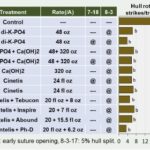
Recent research has found that alkalizing treatments applied at hull split are able to reduce the severity of hull rot caused by Rhizopus stolonifer. Over the past two years, work by Dr. Jim Adaskaveg and colleagues out of UC Riverside has repeatedly shown that several products reduce hull rot incidence. These products included dipotassium phosphate (applied as the product diKaP) applied at 48 ozs/acre, calcium hydroxide applied at 320 ozs/acre, and Cinetis applied at 24 fl. ozs/acre. A single application of each of these products made at 5% hullsplit was shown to be as effective as several fungicide combinations and reduced hull rot strikes by over 75% in comparison to the untreated control. Multiple applications, with one made at early suture split (traditional first navel orangeworm (NOW) timings), did not seem to reduce strikes further.
The cause of the reduction in strikes is unknown. It doesnt appear to have a fungicidal effect on the fungus as often the fungus is present within the hulls. The current thought is that these products neutralize the fumaric acid that is produced by this fungus (this is the acid responsible for limb death). It could also be due to an increase in tolerance to the toxin from the foliar product. Work is ongoing.
With these products, timing is key. Apply around 5-10% hull-split. Since these products may be tank mixed with NOW products as well as other fungicides, confirm compatibility by running a jar test. If struggling in managing hull rot, consider trying these products on a selected blocks to see if they provide any reduction in observed damage. Just remember to leave an area untreated in order to determine treatment effectiveness. Finally, keep in mind that the use of these type of products for hull-rot enters the “grey world” of registration. Follow appropriate labels to keep the application legal.


Mark Brady
June 23, 2018Not sure exactly what’s going on here with this latest work. “Alkaline treatments have been shown to reduce hull rot”; the SDS Sheet for Cinetis lists pH as3.09 – 3.59 (pure product), not alkaline at all but fairly acidic.
Another potential issue is that the label with DiKap, spelled diKaP, may not meet the standards set by California Fertilizer Inspection. In addition a quality Di Potassium Phosphate should be clear in color (free from impurities).
Perhaps this needs a more in depth look.
David Doll
June 25, 2018Mark,
Thanks for the comment. I agree, all of this should have another look. Work from small plot tests often does not have the same efficacy on larger plots. I encourage farmers to try these products while maintaining an untreated area for comparison.
Also, thanks for the comments on Cinetis. I am unsure why Dr. Adaskaveg considers it an alkaline treatment.
David
JJ. Gross
June 19, 2019Is there any work with alkaline products on Aspergillus niger?
David Doll
June 23, 2019No, not yet. With the relatively new discovery of A. niger, there have not been any chemical control methods researched. Hopefully, in a few years, they will have some possible solutions.
David